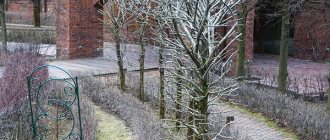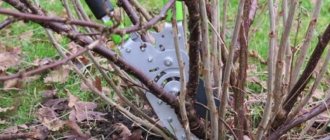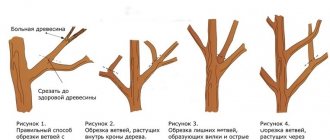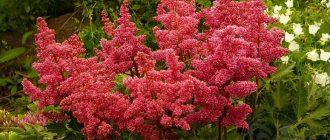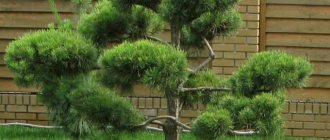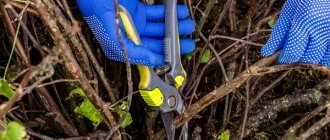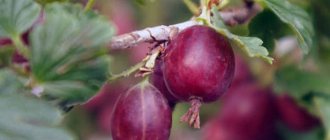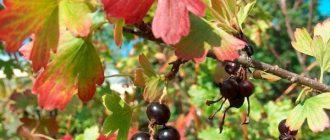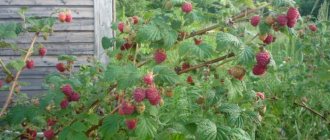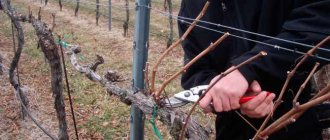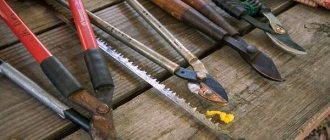Author: Natalya Category: Fruit and berry plants Published: September 19, 2015Republished: February 20, 2019Last edits: November 2, 2020
- Timing of pruning
- When to prune gooseberries
- When to prune blackberries
- Blueberry pruning dates
- When to prune honeysuckle
- Blueberry pruning
With the onset of autumn, life in the garden does not freeze, but begins to slowly fade away, and until the snow falls, gardeners have a lot of work: after harvesting, they need to prepare the plants for wintering and for the beginning of the next growing season, since it is in the fall that the success of next year’s harvest is laid. The easier the garden endures winter, the more grateful it will respond to your care for it. We have already written about how to prepare your garden for winter. In this article we will talk about autumn pruning of fruit bushes on the eve of winter.
Pruning fruit bushes
Berry bushes form the basis of the garden and are a source of vitamins and other useful substances for the human body. Growing fruit bushes is not extremely difficult, but it requires time, effort and special knowledge.
One of the most important points of care is the pruning of fruit bushes, which should be carried out at a time determined by the agricultural technology of the species, since proper pruning has a positive effect on the health, lifespan and productivity of the crop, while untimely or incorrectly carried out pruning can cause serious damage to plants, and in some cases cases and irreparable harm. Autumn pruning of the main fruit bushes is carried out almost annually, and it usually begins when the bush enters a dormant period.
Each type of fruit bush has its own timing - some require pruning in September, others require pruning in October or November, and the methods of this procedure are not the same for all fruit crops, but there are recommendations common to all shrubs:
- Spring gooseberry care is the key to healthy berries
- autumn pruning is done in areas where there are no severe and long frosts, otherwise the bark at the site of the wound may freeze out with the onset of winter, which can lead to the death of the bush;
- You cannot trim plants at temperatures below -10 ºC, because at such a low temperature the wood becomes too fragile, the cut tissue becomes loose, and the tools severely injure the branches;
- do not rush to prune the shrubs planted this year: it is quite possible that you made a mistake with the planting location and will want to move the bush to another part of the garden in the spring - in the new place you will begin to form the crown of the bush;
- autumn pruning is mostly applied to mature bushes and trees;
- be sure to treat cuts of thick branches (from 8 mm in diameter and more) with garden varnish;
- sharpened tools are used as tools for pruning garden shrubs - garden saws and pruning shears. Sometimes you have to work with an axe. A ladder may be needed.
Which shoots to prune depends on how many years a particular type of branch bears fruit. For example, black currant branches bear fruit for 5 years, therefore, branches older than five years must be removed, since they will no longer bear fruit, but will only begin to take away strength and nutrition from younger shoots that are promising in terms of fruiting. There are two methods of pruning: thinning, when the branches are cut off at the very base, and shortening - pruning only the upper part of the shoot. The best time for pruning is the dormant period, when sap flow has stopped.
Rules for forming a blackcurrant bush
Novice gardeners are often interested in how to properly prune currants and gooseberries so as not to harm the crops? Experts advise starting to prune blackcurrant bushes in late autumn. Then in early spring all that remains is to get rid of broken branches and frozen tops.
When 1-2 year old seedlings are planted, they are initially pruned, leaving no more than 3 buds intact. Next year you will need to cut out only weakened shoots. If the gardener sees that the bush was unable to form the required number of viable shoots, the plant should be shortened, leaving no more than 4 buds. The procedure must be carried out again in the 3rd and 4th years of the bush’s life. The formation of a bush usually ends by the 5th year of its life. Since in the 4th year it enters the period of active fruiting.
When pruning, you need to get rid of dry, damaged, diseased, thickening and dead branches. Black currants tend to form fruits on annual growths that appeared in the previous season. Increments of 1st and 2nd branches are rightfully considered the most productive.
Although some of the harvest appears on fruit branches, they tend to die off after a couple of fruiting periods. When branches 1 and 2 increase by more than 40 cm, a decrease in their productivity is observed, and the taste characteristics of the berries suffer.
In addition to pruning, branches that have reached the age of 5–6 years must be cut from the bush. This must be done every year. When the crop is too thick, you can extend the pruning procedure for a couple of years. In this case, in the first year you will need to remove branches that are 5-6 years old. Next year, pruning should be carried out according to the scheme given above. If the gardener believes that the blackcurrant bush is rare, you can leave many young branches that have appeared.
Raspberry pruning
When to prune
Regular (non-remontant) raspberries are best pruned immediately after fruiting, and the timing of pruning depends on the varieties of raspberries you grow in your garden - bushes of early-ripening varieties can be pruned even in the summer, as soon as you have harvested. Bushes of remontant or late-ripening raspberry varieties are pruned in the fall.
Autumn pruning
The lifespan of raspberry branches is two years. The first year the shoots grow, the second year they bear fruit. After fruiting, they gradually dry out, so there is no point in leaving them until spring. Autumn pruning of branches that bear fruit this year is done at the root. In order not to confuse a young shoot with an old one, keep in mind that the bark of second-year branches is darker than that of young shoots. By the way, not all of the annual shoots should be left, because the more shoots there are on the bush, the more modest the harvest of berries will be, so leave no more than 6-8 strong shoots of the current year, which will produce a harvest next year, and cut the rest to the ground.
As for remontant varieties, they bear fruit on the shoots of the first year, so autumn pruning of remontant raspberry bushes is done completely - all branches are cut off at the root and burned. If winters in your area have little snow, then pruning in the fall is not practical, and it is better to postpone it to the spring, and on the eve of winter, simply tie the bushes with twine or twine and bend them to the ground - in this position, a very small amount of snow will be enough for them to overwinter well.
Why (and is it possible) to prune shrubs in the fall?
It has always been a mystery to me: why is autumn pruning of berry bushes viewed with caution by gardening enthusiasts? After all, such a deadline has extremely clear and specific justifications:
- Plants tolerate surgical interventions more easily when they are in a state of rest or preparation for it.
- To make the right decisions, the pruner must clearly see the “skeleton” of the entire plant, not masked by foliage.
Wounds make a tree or shrub vulnerable to frost, so autumn pruning is suitable only for winter-hardy and low shrubs. Currants, gooseberries and honeysuckle are winter-hardy and compact (unlike apple trees), and have the opportunity to spend the frostiest months under a snow “blanket”. They could even withstand winter pruning, but at this time of year it is impossible to approach them - either mud, or ice, or a snowdrift. You can wait until spring, but these crops emerge from hibernation very early. As soon as the opportunity arises to get close to them, the buds have already blossomed! In the fall, after the leaves have fallen, it is convenient to choose a suitable dry day and take your time to do everything necessary.
What if you prune in the summer?
Some lovers combine blackcurrant pruning with harvesting. The persistence of this very strange practice can only be explained by the stoic attitude of black currants to such barbarism. The biggest disadvantage of summer pruning is that in the leafy state the skeleton of the bush is not visible: it costs nothing to tear down something good, but, on the contrary, to leave the bad in place.
Getting rid of unnecessary branches
It's amazing how this simple procedure can scare people. It seems to me that gardeners unwittingly animate plants and do not want to be “executioners”. But the bush does not at all resemble an animal or a person, and its branches are by no means parts of the body. Rather, the plant is a factory, and its branches are workshops.
Closing ineffective divisions and directing resources to successful and new ones is normal practice! Not only a professional can recognize the “extra” – it simply catches the eye. The main thing is to focus not on the tops of the branches, but on the part of the bush that grows from the ground.
Then you will immediately see one, three or five thick, old branches (often with diseased bark). Inspect them and, making sure that they are crowned with short and worthless growth, mark them for removal.
In addition to these, you will probably find one or two broken or dried branches, as well as several twigs almost as thick as a match at the base of the bush. Your task is to get rid of this ballast.
Currant pruning
Timing of pruning
Autumn pruning of black currants can be done directly during harvest, but it is better to do it when the currants shed their leaves and enter a dormant period. Red and white currants are pruned only when the bushes have already dropped their leaves.
Pruning in autumn
Black currants bear fruit on both old and new shoots, but the older the branches become, the fewer berries they bear, and the berries become smaller over time. A young blackcurrant bush is formed from 7-10 strong branches, the rest are cut out. Of the young shoots, 3-4 of the strongest ones are left, cutting off 4-5 of their upper buds. On adult bushes that have reached the age of six, a third of the old branches are pruned annually to the first strong bud, and dry branches are cut to the base. Do not allow growth to grow at the roots - it will interfere with your care of the bush.
- Video about planting and pruning blackberries
After pruning, the bushes are hilled to stimulate the growth of new shoots from the roots, the strongest of which will replace the aged branches next year. It is easy to distinguish old branches from young ones - their bark is darker.
“Caring for raspberries, currants and gooseberries after fruiting”
Red and white currants bear fruit on old branches. When forming a productive bush, leave 2-3 young shoots on it annually, without shortening them, remove the rest. Over time, fruits cease to form on the top of old branches, so they should be shortened to the point of branching. If this does not help, remove them in the same way as dry, diseased, crooked or branches growing inside the bush.
When to prune currants and gooseberries
Berry bushes are pruned mainly in spring and autumn. Summer pruning is performed least often. It is believed that in a leafy state it is impossible to properly inspect the frame and trim the necessary branches.
In the spring, the bushes are carefully inspected and dead, dry and damaged branches are removed. The main thing is to be in time before the sap flow begins.
Autumn is the most favorable time of year for this procedure. The plants are in a dormant period or are preparing for it, the skeletal branches are clearly visible, so the risk of cutting off the wrong shoots is minimal.
Gooseberry pruning
When to prune gooseberries
Gooseberries tend to grow quickly both in height and width, so pruning gooseberry branches is carried out annually after the leaves fall from the bushes.
Bush pruning
Pruning gooseberry bushes first of all involves removing dry, crooked, thickening and old branches at the root, which reduce the yield of the bush. On a young bush, select the five strongest branches and shorten them to a height of 20-25 cm, and remove the rest of the growth. In older bushes, in addition to sanitary pruning, curved and downward-pointing shoots are shortened, and young growth of the current season is cut to the second or third strong bud, without shortening too much the branches that you decided to leave as load-bearing ones. Make sure that the shoots do not grow from the roots; remove them on time.
Preparing the necessary equipment
Before you start pruning for the summer, you should prepare the right gardening tools. It is possible to remove excess branches from berry bushes using a number of tools designed for pruning:
- garden hacksaw;
- tool for cutting knots;
- pruning shears having two pointed blades;
- electric brush cutter;
- garden knife.
Sharp pruning tool
When pruning bushes using any of the tools presented, you should follow a certain sequence of actions.
Important! Before starting pruning work, the selected piece of equipment must be thoroughly cleaned of dirt and disinfected.
Sharpening garden tools is necessary to create perfectly straight cuts.
Note. Fresh cuts must be treated with garden varnish.
It is necessary to process the sections no later than 24 hours after the excess shoots have been removed. Each cut whose diameter is close to 10 millimeters should be lubricated.
Blackberry pruning
When to prune blackberries
When the blackberry crop is harvested, it is time to prune it. Early ripening varieties can be pruned in the summer, immediately after picking the berries; pruning of late ripening varieties is carried out in the fall.
How to trim
Since blackberries are a close relative of raspberries and bear fruit on branches of the second year, those blackberry branches that bear fruit this year are cut off at the root after harvesting. Of the current year's shoots, 6-8 of the most developed ones are left, the rest are removed, as are all diseased, twisted and growing shoots inside the bush. The remaining shoots, if they have grown more than a meter during the season, have their tops cut off by 10-15 cm to stimulate the development of lateral buds and increase the yield of these shoots next year.
Tillage
It is necessary to carefully dig up the soil under berry bushes in autumn so as not to damage the root system of the plants. Digging depth:
- in the aisles - on the bayonet of a shovel,
- in rows between plants - up to 10 cm,
- under bushes no more than 5 cm
In addition to digging up the soil, currant and gooseberry bushes can be lightly hilled. You can also mulch the soil under them, for example, with peat or fallen leaves (not fruit crops).
Abundant watering
In order for plants to stock up on moisture for the winter, they need to be “watered” to their fill. In this case, the main “water bread” is black currant - it needs up to 30 liters of water per bush. The rest are less demanding - up to 20 liters per plant is enough for them.
Carrying out pruning
This operation is very important for shrubs, because in the fall they will begin to grow additional green mass, as a result of which the crown will thicken and, as a result, the plants will bear fruit poorly and become more vulnerable to pests and diseases, as a result of which they may even die.
Black and red currants, gooseberries: it is advisable to prune after harvesting, removing all weak and diseased branches, as well as shoots that are more than five years old. In this case, it is advisable to pinch the tops (except for red currants).
Raspberries and blackberries must first be removed from the fruit-bearing shoots, which must be cut out close to the ground. After this, in order to accelerate the growth and maturation of the side shoots, the length of which has reached 0.5 m, it is necessary to pinch the latter.
Author: Elena Popleva, Candidate of Agricultural Sciences
TOOLS FOR CRAFTSMAN AND CRAFTSMAN, AND HOUSEHOLD GOODS VERY CHEAP. FREE SHIPPING. THERE ARE REVIEWS.
Below are other entries on the topic “How to do it yourself - for a homeowner!”
- How you can measure the required amount of fertilizer using improvised means. Memo for the gardener - mass...
- Do-it-yourself bench for a bath - photo Bench for a bath - how...
- Do-it-yourself solutions for processing and spraying seedlings How to prepare solutions for seedlings...
- Conventional designations: floor coverings, laminate, ceramic tiles Laminate and tiles are symbolic...
- How to help trees after: hurricane, hail, rain and heat: table-reminder ELEMENTS IN THE GARDEN: ELIMINATING THE CONSEQUENCES...
- Modern light sources instead of light bulbs How to light a house instead of light bulbs...
- Laying floor joists - calculation table How to calculate the thickness of the boards and...
Subscribe to updates in our groups and share.
Let's be friends!
With your own hands > Summer cottage garden and vegetable garden > Pruning and grafting > Autumn pruning of currants and gooseberries - how to prune these bushes correctly
Blueberry pruning
Blueberry pruning dates
Blueberries bear fruit on last year's shoots. For the first couple of years, blueberries are not pruned at all; in the third year, all fruit buds on the plant are removed. All pruning procedures are carried out after leaf fall.
- Honeysuckle: growing in the garden, types and varieties
Autumn pruning of bushes
In the fourth year from the moment the plant is planted in open ground, that is, when the plant is 5-6 years old, branches that grow too low are cut off from the bush, and small growths are removed around the bush. Three years after planting a blueberry seedling in the garden, annually cut out all the low spreading branches, leaving only upright growth, thin out the middle of the bush, removing all weak, diseased and old branches.
Young shoots that do not have time to grow and strengthen before winter should also be removed. Ideally, you should leave only skeletal branches and strong shoots on the bush, no more than five or six of the annual shoots. Erect blueberry varieties should not be allowed to become too overgrown in the middle, and low-growing branches should be removed from spreading varieties.
Why trim bushes?
Pruning of berry crops is carried out for a specific purpose. If the procedure was performed correctly, it will perform the following tasks:
- bush formation;
- rejuvenation of adult plants. Moreover, even old bushes can be rejuvenated;
- extending the period of fruiting and life of crops;
- rationing the number of shoots. Allows for proper distribution of nutrients in the plant;
- creating optimal conditions for fruiting. Thanks to this, the yield of pruned bushes increases significantly;
- prevention of diseases and parasites;
- giving the bushes a well-groomed and decorative appearance.
Pruning the branches of berry crops is a mandatory care that any novice gardener should carry out from the moment they plant seedlings in the garden.
Pruning honeysuckle
When to prune honeysuckle
Many experts believe that honeysuckle does not need pruning until it is 5-7 years old. Honeysuckle bears fruit on annual shoots, but enters full fruiting only in the eighth year of life. It is best to prune honeysuckle in the fall, after the leaves have fallen, but do not delay this procedure until the first snow.
How to prune in autumn
Starting from the eighth year of life, annual thinning and rejuvenating pruning of honeysuckle is carried out, during which the aging and too thick tops of the skeletal branches are removed, gradually strengthening the role of replacement shoots growing in the middle part of the old skeletal branch as new bearing branches. By pruning, the peripheral zone is thinned out. Make sure that the lower parts of the branches are not exposed too much.
In general, on young bushes, slight thinning with shortening of shoots prevails, and fully fruiting bushes are thinned moderately, also slightly shortening the shoots. Old bushes are subject to severe thinning. Leave one third of the fruiting branches without pruning at all, unless it is required for sanitary purposes. Over time - upon reaching 8-10 years of age - these branches are cut one by one “to the stump”.
Other garden shrubs
What other fruit bushes are pruned in the fall?
Blueberry pruning
Pruning of blueberries is carried out mainly at the very beginning of spring, although pruning can also be done in the fall, when the blueberries have shed their leaves. Bushes that have reached 3-4 years of age are pruned, removing dried, damaged and diseased branches, leaving 6-8 developed branches as a skeleton. Branches older than 4 years are cut at a height of 20 cm from the ground, and side shoots with buds are cut out completely. In order to rejuvenate the bush and increase its productivity, bushes older than fifteen years are pruned completely at a height of 20 cm from the surface of the ground.
Pruning serviceberry
Irgu begins to be pruned at the age of three, leaving only two or three strong shoots from the annual growth, and removing the rest. As a result, the formed bush should have about fifteen branches of different ages. Branches that have reached the age of six should be removed “to the ring”, leaving developed shoots of basal growth to replace them.
Rosehip pruning
It is also better to prune rose hips in the fall. In adult bushes, all branches older than five years are cut out, although they can bear fruit for seven or eight years, however, the qualitative and quantitative indicators of their yield are noticeably reduced, and they will consume food and water in the same quantities. A replacement for pruned old branches is formed from the strongest shoots of the basal shoots.
Actinidia pruning
Pruning of plants that are more of a vine than a shrub is often also done in the autumn. Actinidia, for example, requires pruning in November, when its leaves fall and the first hard frosts pass. When pruning, remove all thin, weak, crown-thickening and broken shoots. One or two vines that have been bearing fruit for three years are pruned to a low-lying powerful young vine.
We will tell you about autumn pruning of ornamental shrubs in a separate chapter.
Caring for pruned bushes
After pruning the gooseberry and currant fruit bushes in early spring, it is necessary to provide proper care to the plants. Thanks to such actions, the bushes will be able to recover faster and also bring a high yield.
Did you know? The amount of vitamin C in unripe blackcurrant berries is several times greater than in ripe ones.
Care consists of the following manipulations:
- seal all cut areas with garden varnish;
- apply mineral (superphosphate, urea, potassium chloride, ammophosphate, etc.) and organic (humus, manure) fertilizers to the plants, following the instructions for use;
- carry out shallow loosening of the soil around the bushes to provide the roots with access to oxygen and not damage them;
- if necessary, water with warm water at the rate of 1-2 buckets for each bush;
- To retain moisture in the ground, cover the tree trunk area with mulch.
In order for gooseberry and currant bushes to bear fruit annually and produce a high yield of high-quality and sweet berries, it is necessary to regularly prune them in the autumn or spring, taking into account all the recommendations of experienced gardeners. Thanks to this, the plants will live a long time, not get sick and delight their owners with abundant fruiting.
